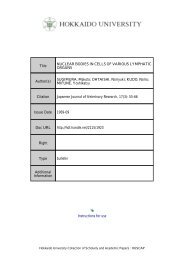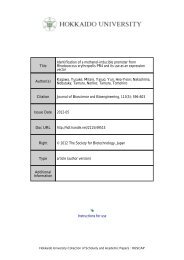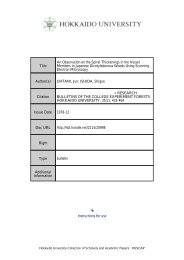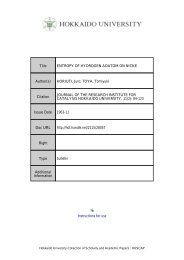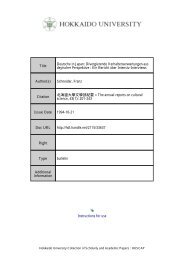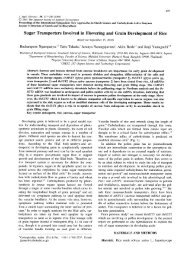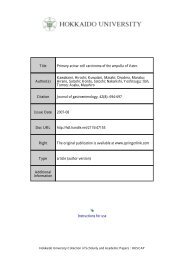ADSORPTION ISOTHERM AND THE STATES OF ADSORPTION
ADSORPTION ISOTHERM AND THE STATES OF ADSORPTION
ADSORPTION ISOTHERM AND THE STATES OF ADSORPTION
You also want an ePaper? Increase the reach of your titles
YUMPU automatically turns print PDFs into web optimized ePapers that Google loves.
J. Res. Inst. Catalysis, Hokkaido Univ., Vol. 24, No.3, pp. 159 to 186 (197')\j "<br />
<strong>ADSORPTION</strong> <strong>ISO<strong>THE</strong>RM</strong> <strong>AND</strong> <strong>THE</strong><br />
<strong>STATES</strong> <strong>OF</strong> <strong>ADSORPTION</strong>*)<br />
By<br />
Juro HORIUTI**) and Tomiyuki TOYA**)<br />
(Received July 9, 1976)<br />
Abstract<br />
Existence of the two distinctly different states, the r- and s-states, of hydrogen adatom<br />
was previously deduced from the quantum-mechanical theory of adsorption developed by<br />
one of the present authorslO). The energy of the r-state adsorption of a single hydrogen<br />
adatom without interaction with other adatoms (an adatom free from interaction with other<br />
ones will be termed a single adatom in what follows) was shown lower than that of s-state<br />
one on any crystal plane of nickel and the energy of either state is lowest on the least<br />
dense (HO)-plane. Steps, kinks, and defects on a lattice plane furnish s-states of extraordinarily<br />
low energy.<br />
The consequent distribution of sites over the energy of a single adatom should be<br />
uniquely deduced from isotherm observed at any temperature by the distribution function<br />
method, if the neglect of the interactions among adsorbates, implied in the latter method,<br />
were applicable at all. The distribution function exactly based on the observed isotherm<br />
was thus deduced by applying the SOMMERFELD's method of deducing the free energy of<br />
Fermi gas from the known distribution function of quantum states over energy inversely to<br />
the present problem. The distribution function of sites thus deduced for the dissociative<br />
adsorption of hydrogen shifted considerably with the observation temperature, from 0° to<br />
300°C, of the isotherm. This contradicts the neglect of the interaction implied, since experimedtal<br />
facts exclude the change of the surface structure of the adsorbents over the<br />
temperature range in question from being alternatively responsible for the shift.<br />
Experimental informations indicated that the adsorbent's surface consists of crystal<br />
planes each big enough to secure the physical identity of metal atoms on it. The interaction<br />
between r-adatoms was shown repulsive as caused by the exchange repulsion between<br />
hydrogen adatoms and their competition for metal electrons, besides by the dipole interaction<br />
in case of charged adatom. There exists practically no interaction between s-adatoms<br />
nor between $- and r-adatoms. The model of exclusive adsorption of r-adatoms on (110)-<br />
*) In 1963 the Russian translation of the article was published in Vol. IV, No.1 of<br />
Kinetica i Katalis. The Editorial Board of the Journal of the Research Institute for<br />
Catalysis has the pleasure of presenting here the original English version of the<br />
article for the benefit of a larger circle of scientists. The permission of the Editorial<br />
Board of Kinetica i Katalis is gratefully acknowledged (Editor).<br />
**) Research Institute for Catalysis, Hokkaido University, Sapporo 060, Japan.<br />
159
160<br />
J. HORIUTI and T. Toy A<br />
plane allowed for the repulsive interaction (the crystal plane model) should in consequence<br />
reproduce the bulk of the adsorption isotherm, provided that (HO)-plane makes a good<br />
portion of the surface, whereas sites of low energy furnished by the imperfections are just<br />
a minority. At higher coverage the theoretical isotherm may fall too low, because the<br />
preference of the r-state adsorption on (HO)-plane is more or less counterbalanced by<br />
repulsion enhanced with coverage. The experimental results were satisfactorily accounted<br />
for on the base of the above crystal plane model extended to include the additional s-state<br />
adsorption on the same plane 36 • 3 7).<br />
The preferential desorption of the portion later adsorbed observed by means of isotopic<br />
tracer 13 ) was shown not exclusively to evidence the distribution function method but equally<br />
accounted for on the basis of the crystal plane model with proper allowance for the<br />
interaction.<br />
The distribution function method implying the neglect of interaction was thus concluded<br />
inapplicable, whereas the crystal plane model, extended as above, was shown in accordance<br />
with the experimental results.<br />
Introduction<br />
There are two schools of conception of the surface structure of adsorbents,<br />
from which isotherms are theoretically deduced, i. e., that of homogeneous<br />
surface with physically identical adsorption sites originating from<br />
LANGMUIR!) and that of inhomogeneous one with sites of diverse properties<br />
especially of different heat of adsorption initiated by H. S. T A YLOR 2 ). The<br />
former model has been elaborated by ROBERTS 3 ) and OKAMOTO, HORIUTI and<br />
HIROT A 4) by assigning the homogeneous surface to a crystal plane of metallic<br />
adsorbent and taking account of the repulsive interaction among adsorbates,<br />
whereas the latter has been developed into that underlying the distribution<br />
function method5 ), where the interaction was ignored or the energy of adsorbate<br />
taken particular to the site it occupied irrespective of the arrangements<br />
of other adsorbates. The former might be called the crystal plane<br />
model and the latter the distribution model in what follows.<br />
It has been observed6 ) by field emission microscope that the surface of<br />
tungsten tip consists of a single crystal, which exposes different crystal planes<br />
each big enough to ensure the physical identity of the majority of metal atoms<br />
on it. SUHRMANN71 has observed that evaporated metal film of nickel consists<br />
of single crystals of the linear dimension of ca. 100 A comparable to that<br />
on the above tungsten tip. Single crystals of the linear dimension of at least<br />
200 A are observed with reduced nickel powder8) or tungsten powder9) used<br />
ordinarily in the adsorption experiments. It might be admitted from these<br />
experimental results that the surface of these adsorbents consists of lattice<br />
planes each big enough in the above sense.
Adsorption Isotherm and the States oj Adsorption<br />
We have to accept, on the other hand, that the energy of adsorbate<br />
is considerably diverse. One of the present authors 10l has shown on the<br />
basis of the quantum-mechanical theory of metal electrons that there exist<br />
two distinctly different states of adsorption of hydrogen atoms; the one is<br />
that of the adsorption of usual sense with the relevant adatom being situated<br />
outside the electronic surface of metal and the other that with the adatom<br />
just inside the electronic surface, as called by him respectively the r- and<br />
s-states of adsorption lOl • The energy of the r- and s-states of the same metal<br />
varies from a crystal plane to another and steps, kinks, and defects make<br />
a further difference in the energy of adatom.<br />
It follows that the distribution model is exact, provided that the interaction<br />
among adsorbate were ignorable. If then, the distribution function<br />
of the energy of adsorbates should be concordantly deduced from any of<br />
adsorption isotherms observed at different temperatures, insofar as the thermal<br />
rearrangements of surface metal atoms of adsorbent is excluded, hence<br />
the distribution function itself remain constant. One of the present authorsll)<br />
has thus investigated the consistency of the distribution model with the negative<br />
conclusion that the distribution function of hydrogen on nickel as well<br />
as on tungsten deduced from observed isotherms does shift markedly with<br />
the temperature of the observation ranging from ooe to 300 o e, where the<br />
thermal rearrangement of adsorbent's surface is precluded by experimental<br />
facts. This leads inevitably to the conclusion that the interaction among<br />
adsorbates is by no means ignorable.<br />
It was now tried theoretically to reproduce the observed adsorption isotherm<br />
of hydrogen on nickel, allowing for the interaction and admitting the<br />
adsorbent surfaces composed of different lattice planes. It is evidenced that<br />
hydrogen is dissociated to form statistically independent adatoms on nickel at<br />
least at low coverageS). The adatoms should then predominantly adsorb on<br />
the lattice plane, on which the energy of adatoms is sufficiently low. The<br />
r-adatom on (llO)-plane is the lowest in energy among adatoms in the absence<br />
of interaction as shown in § 1 and the interaction is repulsive between radatoms<br />
as deduced in § 3 from every conceivable cause, whereas it exists<br />
scarcely between s-adatoms or between r- and s-adatoms lOl • Imperfections<br />
such as steps, kinks, and defects may possibly furnish adsorptive sites of<br />
considerably low energy but probably be of little adsorptive capacity.<br />
The isotherm of the dissociative adsorption of hydrogen on the (llO)-plane<br />
was thus theoretically worked out allowing for the interaction at different<br />
temperatures from 0° to 300 0e as shown in § 6 and § 7. Deviation of the<br />
theoretical isotherms is expected at extremely low coverage on the one hand<br />
161
162<br />
J. HORIUTI and T. Toy A<br />
because of the contribution from the imperfections mentioned above and at<br />
higher coverage on the other hand, since the preference of r-state adsorption<br />
on the (llO)-plane is more or less counterbalanced by the repulsive interaction<br />
of r-adatoms, which raises the energy of the adatoms.<br />
The theoretical isotherms thus worked out accounts in the main quantitatively<br />
for the observed ones 12 ) but the expected deviations reveal themselves<br />
at lower and higher extremities of coverage as shown in § 7; the<br />
deviation at lower coverages is explained qualitatively attributing it to the<br />
imperfections, whereas that at higher coverge is satisfactorily reproduced by<br />
ascribing it to the s·state adsorption on the (llO)-plane.<br />
It might now be questioned how to reconcile the above conclusion with<br />
the experimental results of the differential isotopic method 13 ) that the portion<br />
adsorbed later is desorbed initially in preference to that adsorbed earlier as<br />
observed by isotopic tracer, which is taken as the exclusive evidence for the<br />
distribution model, on account of the inability of the crystal plane model<br />
to explain it as based on the simple assumption of the repulsive potential<br />
proportional to the coverage. It was shown by one of the present authors W<br />
as summarised in § 8 that the experimental result of the differential isotopic<br />
method is adequately derived from the crystal plane model, if allowed properly<br />
for the repulsive interaction and for the appearance mentioned above of the<br />
s-state on the same plane at higher coverage.<br />
On these grounds it is concluded that the distribution model is inapplicable<br />
but the crystal plane model with the above extension is the sound basis of<br />
accounting for the observed isotherms.<br />
Detailed accounts will be given of the above points in the following sections.<br />
§ 1. Energy of Single Adatom<br />
Consider a hydrogen adatom in the absence of interaction on a perfect<br />
crystal plane of a metal, which will be called a single adatom in what follows.<br />
The energy Wr of a single adatom at the r-state is determined by the equation<br />
10 )<br />
based on the quantum-mechanical theory of adsorption developed by one of<br />
the present authors 10 ), where<br />
Ro: repulsive potential of the adatom due to metal electrons and metal ions,<br />
E+: energy of the H+ -state of the adatom averaged over the vacant energy<br />
( 1)
Adsorption Isotherm and the States of Adsorption<br />
level of the metal, to which the electron of the adatom is transferred,<br />
N v : number of the vacant levels of free electrons in the metal,<br />
iL: energy of H--state of the adatom, inclusive of the repulsive potential<br />
due to metal atoms, averaged over the occupied levels in the metal,<br />
from which an electron removed to the adatom to form H-,<br />
N: the number of the occupied levels in the metal,<br />
I Vv I: mean value of the matrix element between Is-electron of the adatom<br />
and a vacant level, and<br />
I Vol: mean value of the matrix element between an occupied level and the<br />
electron trapped by H.<br />
It has been shown that the theoretical values of .j N v Vv and .j N Vo yield<br />
by (1) the value of heat of adsorption of the right order of magnitude lOJ •<br />
We see that iL < E+ for usual metallic adsorbents, for which the work<br />
function is smaller than the mean of the ionization potential 13.6 e V and<br />
the electron affinity 0.7 e V of hydrogen atom, admitting that electron is transferred<br />
from the adatom mainly to the levels near the Fermi level or reversely.<br />
Besides, .j N Vo is found slightly larger than .j N v Vv as calculated for copper<br />
and nickel lO ). Ignoring the second term on these grounds the above equation<br />
shows qualitatively that Wr is the higher, the greater the E_ and the Ro.<br />
The E_ increases now with increase of the work function of the relevant crystal<br />
plane, which increases with increase of density of metal atoms on it due<br />
to the decrease of the smoothing effect as discussed by SMOLUCKOWSKI 15 ) and<br />
verified by field emission microscopic 0 bservations 6 ). The repulsive potential<br />
Ro should increase as well with increase of the density of metal ions on<br />
the crystal plane. It follows that the energy of r-adatom is lower on a less<br />
dense crystal surface.<br />
The above conclusion is regarded as the incorporation of the following<br />
two ones. OKAMOTO, HORIUTI and HIROTA 4 ) have concluded that the energy<br />
of hydrogen adatom on nickel is lowest on (llO)-plane taking account of the<br />
repulsion exerted by metal atoms other than that to which the adatom is<br />
bonded.<br />
On the other hand, Wr is given by the Eley's empirical rule as 16 ,17)<br />
where W(M-M) is the bond energy between two metal atoms, as determined<br />
by dividing the heat of evaporation of solid metal by the coordination number<br />
of a metal atom, W(H - H) the dissociation energy of hydrogen molecule<br />
and X M or X H the electronegativity of the metal or hydrogen atom, i. e., 0.355<br />
163
166<br />
J. HORIUTI and T. Toy A<br />
tic ally constant. It requires - 2 e V to make a defect or so-called damage<br />
inside metals2!l, hence about one half of this amount of energy to make an<br />
imperfection on the surface. Since this amount of energy is hardly supplied<br />
thermally over the temperature range in question, we might safely exclude<br />
any possibility of rearrangements of surface metal atoms, hence admit a constant<br />
distribution of sites over the energy of single adatom independent of<br />
temperature.<br />
One of the present authors has deduced 22 ) the distribution function F(E)<br />
from the adsorption isotherm v=v(p) observed at different temperatures<br />
according to the equation<br />
v = r: fJ(E, f/) F(E) dE,<br />
(2. v)<br />
where F(E) dE is the number of sites with the energy of adatom lying between<br />
E and E+dE in terms of the amount of gas fully adsorbed there<br />
and fJ or v the fraction of these sites occupied or the total amount of gas<br />
adsorbed at the hydrogen pressure P. The fJ is expressed in accordance<br />
with the premised absence of interaction among adatoms by the Langmuir<br />
type function<br />
{ ( E-f/)}-I<br />
fJ = l+exp -f
Adsorption Isotherm and the States of Adsorption<br />
deduced 22 ) just over the range, where F(E) is directly based on the observed<br />
v, by applying the SOMMERFELD'S method of evaluating Ii of Fermi gas from<br />
known F(E), inversely to the present problem as follows. According to<br />
SOMMERFELD 25 ) ,<br />
Cp 00 (n- RT)2'" { d 2 "'-l F(E) }<br />
v=J_oo F (E)dE+22';:j- (2m-)!-(2 2m -1)B", -dpm--l - E=p' (3. a)<br />
where Bm is the Bernoulli's number, i. e., 1/6, 1/30, 1/42,······ for m = 1,2,<br />
3 ....... respectively. KEII has shown 26 ) that the ROGINSKY'S approximation 5 )<br />
for evaluating F(E) from observed v corresponds to the first term of (3. a)<br />
only being retained and he worked out 26 ) F(E) and hence the heat of adsorption<br />
reserving first two terms.<br />
It has now been shown 22 ) retaining the whole terms that (3. a) leads with<br />
special reference to (2. F), exactly to the equation<br />
v sm n-c<br />
F (E)E=p = RT----n-- .<br />
(3. b)<br />
Eq. (3. b) defines the function F(E) just over the range of E equal to Ii,<br />
which is determined directly by observations by (2. Ii), thus basing F(E) solidly<br />
upon observations.<br />
The explicit function F(E) is obtained from (3. b) by substituting Ii from<br />
(2. F), expressing P, thus introduced, by (2. Ii) and identifying Ii with E for<br />
F(E)E=p, as<br />
V l sin 2n-c Clil 2cE<br />
logjo F(E) = loglo -- n-RT- - 2.301
170<br />
J, HORIUTI and T. Toy A<br />
two hydrogen adatoms each bonded to a surface metal atom.<br />
(i) Exchange repulsion<br />
The potential between the two hydrogen atoms is given quantum-mechanically<br />
as Q-J(2, where Q or J is the Coulomb or exchange integral<br />
between the two hydrogen atoms. The Q-J(2 will be called the exchange<br />
repulsion in what follows. EYRING and POLANYI have evaluated 29 ) Q or J<br />
as 10% or 90% respectively of the Morse function of hydrogen molecule<br />
in calculating the activation energy of the elementary reaction H + H 2- H2 +<br />
H, on which base the exchange repulsion is - 35 % of the Morse function.<br />
It is well-known that the absolute value of the Morse function of hydrogen<br />
is too large SO ) at distances appreciably larger than the nuclear separation<br />
of hydrogen molecule, which are now in question. The above estimate<br />
of the exchange repulsion may in consequence be too large.<br />
(ii) Potential of interaction through metal electrons<br />
EUCKENSl> has pointed out the repulsion between adatoms through the<br />
intermediary of metal electrons. One of the present authors formulated the<br />
interaction of this cause on the basis of the quantum-mechanical theory of<br />
adsorption 10 ) developed by him as follows.<br />
Metal electrons impinging the metal surface within the cross section<br />
of an adatom are trapped and reemitted thus participating in the bond formation<br />
in accordance with (1) on the one hand and increasing the electric<br />
resistance of the metal on the other hand lO ). The competition for metal<br />
electrons occurs as their cross sections overlap each other, to weaken the<br />
bonds each of the adatoms with metal, hence the repulsive interaction between<br />
them. The above cross section was theoreticallylO) worked out at ca.<br />
47!'r;, where rs is the radius of atomic sphere of metal atom, in a fair agreement<br />
with its value 3-47!'r; deduced from the observed effect of adsorption<br />
on the resistance of evaporated metal film 32 ), which is appreciably larger than<br />
the area allotted to a surface metal atom.<br />
(iii) Electrostatical interaction potential<br />
Adatoms may be more or less charged to contribute to the repulsive<br />
potential by electrostatical interaction between dipoles thus formed as discussed<br />
by de BOER S3 ) ; as he remarks, however, the repulsive potential of this<br />
cause is too small to account for the overall one.<br />
The exchange repulsion amounts to 0.1019, 0.0134, or 0.0028 e V for the<br />
distance, 2.49 A, 3.52 A, or 4.31 A, which happens respectively to be the first,<br />
second, or third nearest distance between adatoms on (llO)-plane*). This<br />
value is not necessarily smaller than the overall repulsive potential at the<br />
*) Cf. § 4.
Adsorption Isotherm and the States of Adsorption<br />
respective distance, because of the possible overestimate through the Morse<br />
function as mentioned above. We have proceeded to express the overall<br />
repulsive potential Rr, Rn or Rm at the respective distance as<br />
Rr = 0.1019A eV , Ru = 0.0134A eV , RIll = 0.0028A e V .<br />
(5. I), (5. II), (5. III)<br />
and to adjust factor A to observations as described in § 7.<br />
§ 4. States of Adatoms<br />
The surface of metallic adsorbents may consist, as mentioned in the<br />
introduction, of different crystal planes associated with imperfections and any<br />
of these planes of adsorption may provide the r· and s-state adsorption sites.<br />
It may safely be assumed, however, that the imperfections provide quite<br />
a minority of adsorption sites especially those of extraordinarily low energy<br />
as referred to in § 1. This is in accordance with the experimental results of<br />
GOMER 27 ) and SWEET and RIDEAL 2B ) that the initial adsorption on a clean<br />
surface with extraordinary large heat of adsorption amounts just to 1.5-5.0%<br />
of the total coverage. The place of the bulk of adsorption may thus be<br />
taken as the crystal planes, each of them in general accommodating adatom<br />
with r- or s-state.<br />
As stated in § 1 with regard to nickel, the r-state on (110)-plane is of<br />
the lowest energy among both the kinds of states on different crystal planes.<br />
It follows that the r-state adsorption on (110)-plane is a good approximation<br />
except at higher coverage, where the low energy of a single adatom on (110)plane<br />
is more or less counterbalanced by the repulsive potential, provided<br />
that (110)-plane makes a good portion of the surface as assumed in what<br />
follows.<br />
At higher coverage the s-state adsorption on (110)-plane or r-state one<br />
on other crystal plane should appear first to contribute comparably to the<br />
adsorption, inasmuch as the energy of a single adatom of r-state is constantly<br />
lower than that of s-state on every lattice plane as mentioned in § 1. In<br />
that case the observed amount of adsorption should deviate too high above<br />
the theoretical one based on the exclusive r-state adsorption on (110)-plane.<br />
The latter theoretical isotherm is derived on the base of the model<br />
specified below. Every metal atom on the (110)-lattice plane provides a site<br />
of adsorption of a hydrogen adatom right above it at equal height, so that<br />
the centres of the sites of adsorption compose another (110)-plane congruent<br />
with the basic one as shown in Fig. 5. A site 0'0 has thus two first nearest<br />
sites 0'1 and 0'2, two second nearest sites, 0'3 and 0'4, and four third nearest<br />
171
Adsorption Isotherm and the States of Adsorption<br />
rate proportional to the amount of each portion adsorbed.<br />
One of the present authors has now shown w that the experimental result<br />
of the differential isotopic method is equally accounted for on the basis of the<br />
crystal plane model, if allowed for the interaction by a proper approximation<br />
instead by the proportional one. The underlying principle is illustrated first<br />
with the adsorption of atomic hydrogen gas on (llO)-plane, allowing for the<br />
interaction of adatoms by the first approximation.<br />
The first approximation allows for the repulsive interaction with the first<br />
nearest neighbours only, so that our problem is reduced to that of one-dimensional<br />
arrangements of adatoms on the line of adsorption sites through<br />
(11t (10, and (12 in Fig. 5 and on these parallel to it. He has calculated W the<br />
state of the linear adsorption of hydrogen atoms at 50°C and r=3 X 10 3 , where<br />
8= 0.542 according to § 7, by comparing the probabilities of different occupations<br />
of J: according to § 6, with the following results. Among 1000 sites<br />
linearly arrayed, 542 ones are occupied and 1000 - 542 = 458 ones are vacant.<br />
Among 542 occupied sites, 350 ones have on directly neighbouring adatoms,<br />
172 ones have each only one neighbouring adatom and 20 ones each two<br />
neigh bouring adatom.<br />
Among 458 vacant sites, only one has no directly neighbouring adatom,<br />
42 have each one neighbouring adatoms and the remaining 415 have each<br />
two ones. The one unoccupied site without neighbour and 42 ones each<br />
with only one neighbour are associated with lower energies of adsorption<br />
than the 415 vacant sites each with two neighbours. These vacant sites are<br />
now supposed to be occupied by 121 new adatoms, which increases the coverage<br />
from 0.542 to 0.663. The calculation shows w , assuming the full occupation<br />
of sites of lower energy by the new adatoms that 99 among them<br />
are obliged to take seat in the sites of highest energy, i. e., those each with<br />
two neighbours.<br />
The occupation of vacant sites raises however the energy of the previous<br />
occupants by the repulsive potential due to the new neighbours. The adatoms<br />
of the highest energy with two neighbours among the previous occupants<br />
are thus increased from 20 to 63 14 ). Admitting that adatoms of the<br />
highest energy are desorbed initially, both the portions first and subsequently<br />
adsorbed are recovered initially on desorption at the ratio 63: 99. On the<br />
basis of the proportional approximation this ratio is just that of the respective<br />
coverages, i. e., 542: 121.<br />
The above arguments may be summarized as follows. Previous occupants<br />
take easy seats of low energy occupying the linear sites alternately in<br />
the main thus avoiding the repulsive interaction, leaving cramped seats to new-<br />
179
184<br />
.1. HORIUTI and T. Toy A<br />
The values of {}r in the Table are those arbitrarily taken around the<br />
probable range of its value for the theoretical presentation of the adsorption<br />
isotherms 37l and of the effect of adsorption on the electric resistance 32l • The<br />
above values of Sa is in satisfactory agreement with those derived from observation<br />
in Table 1; the apparent contradiction is thus reconciled, whereas<br />
the s-state of adatom is established.<br />
References<br />
1) 1. LANGMUIR, Trans. Fraraday Soc., 17, 617 (1922).<br />
2) H. S. T AYLOR, Proc. Roy. Soc., A 108, 105 (1925).<br />
3) ]. K. ROBERTS, Proc. Roy. Soc., A 152, 445 (1935); Nature, 137, 659 (1936).<br />
4) G. OKAMOTO, J. HORIUTI and K. HIROTA, Sci. Papers Inst. Phys. Chern. Research,<br />
Tokyo, 29, 223 (1936).<br />
5) S. Z. ROGINSKY, Adsorption and Catalysis 011 Non-ull1form SUI/ace, Acad. Sci.<br />
USSR, 1948: of ]. G. TOLPIN, G. S. JOHN and E. FIELD, Advances ill Catalysis,<br />
5, 215 (1953).<br />
6) See, for example, R. GOMER, Advances in Catalysis, Academic Press, Inc., New<br />
York, 7, 93 (1955).<br />
7) R. SUHRMANN, G. WEDLER, H.-G. WILKE and G. REUSMANN, Z. physik. Chern.,<br />
N. F., 26, 85 (1960).<br />
8) T. KWAN, This Journal 1, 81 (1949).<br />
9) W. G. FRANKENBURG, ]. Am. Chern. Soc. 66, 1827 (1944); ibid., 66, 1838 (1944).<br />
10) T. Toy A, This .1 ourna!, 6, 308 (1958); ihid., 8, 209 (1960).<br />
11) J. HORIUTI, ihid., 1, 8 (1948-51), See especially §§ 17-20.<br />
12) T. KINUY AMA and T. Kw AN, ihid., 4, 199 (1957).<br />
13) S. Z. ROGINSKY, Probleme of Kinetics and Catalysis, USSR, 9 (1957); N. KEIER<br />
and S. Z. ROGINSKY, Bull. Acad. Sci. USSR, Chemistry Section, 1953, p. 27.<br />
14) T. Toy A, This Journal, 9, 134 (1961).<br />
15) R. SMOLUCKOWSKI, Phys. Rev., 60, 661 (1941).<br />
16) D. D. ELEY, Disc. Faraday Soc., 8, 34 (1950).<br />
17) D. R. STEVENSON, ]. Chern. Phys., 23, 203 (1955).<br />
18) See for example, Ref. (15).<br />
19) T. TOY A, This Journal, 8, 217 (1960).<br />
20) Cf. the second paper of Ref. (10).<br />
21) See for example, A. SEEGER, Hand. Phys., VII/I, Springer, 1955, p. 403.<br />
22) J HORIUTI, This Journal, 9, 108 (1961).<br />
23) R. SIPS, ]. Chern. Phys., 16, 490 (1948); ibid., 18, 1024 (1950).<br />
24) O. M. TODES and A. K. SONDAREV A, ]. App\. Chern. USSR, 21, 693 (1948).<br />
25) See for example, ]. E. MAYER and M. G. MAYER, Statistical Mechanics, John<br />
Wiley and Sons, 1940, p. 383 and ]AHNKE-EMDE, Table of Functions, Leipzig and<br />
Berlin, 1933, p. 319-322.<br />
26) T. KEII, This Journal, 7, 99 (1959).




